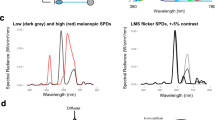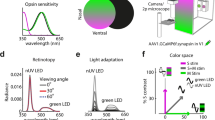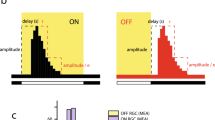Abstract
Noise in the responses of cone photoreceptors sets a fundamental limit on visual sensitivity, yet the origin of noise in mammalian cones and its relation to behavioral sensitivity are poorly understood. Our work here on primate cones improves understanding of these issues in three ways. First, we found that cone noise was not dominated by spontaneous photopigment activation or by quantal fluctuations in photon absorption, but was instead dominated by other sources, namely channel noise and fluctuations in cyclic GMP. Second, adaptation in cones, unlike that in rods, affected signal and noise differently. This difference helps to explain why thresholds for rod- and cone-mediated signals have different dependencies on background light level. Third, past estimates of noise in mammalian cones are too high to explain behavioral sensitivity. Our measurements indicate a lower level of cone noise and therefore help to reconcile physiological and behavioral estimates of cone noise and sensitivity.
This is a preview of subscription content, access via your institution
Access options
Subscribe to this journal
Receive 12 print issues and online access
$209.00 per year
only $17.42 per issue
Buy this article
- Purchase on Springer Link
- Instant access to full article PDF
Prices may be subject to local taxes which are calculated during checkout







Similar content being viewed by others
References
Baylor, D.A., Matthews, G. & Yau, K.W. Two components of electrical dark noise in toad retinal rod outer segments. J. Physiol. (Lond.) 309, 591–621 (1980).
Baylor, D.A., Nunn, B.J. & Schnapf, J.L. The photocurrent, noise and spectral sensitivity of rods of the monkey Macaca fascicularis. J. Physiol. (Lond.) 357, 575–607 (1984).
Rieke, F. & Baylor, D.A. Molecular origin of continuous dark noise in rod photoreceptors. Biophys. J. 71, 2553–2572 (1996).
Fu, Y. & Yau, K.W. Phototransduction in mouse rods and cones. Pflugers Arch. 454, 805–819 (2007).
Donner, K. Noise and the absolute thresholds of cone and rod vision. Vision Res. 32, 853–866 (1992).
Field, G.D., Sampath, A.P. & Rieke, F. Retinal processing near absolute threshold: from behavior to mechanism. Annu. Rev. Physiol. 67, 491–514 (2005).
Schneeweis, D.M. & Schnapf, J.L. Noise and light adaptation in rods of the macaque monkey. Vis. Neurosci. 17, 659–666 (2000).
Rieke, F. & Rudd, M.E. The challenges natural images pose for visual adaptation. Neuron 64, 605–616 (2009).
Rieke, F. & Baylor, D.A. Origin and functional impact of dark noise in retinal cones. Neuron 26, 181–186 (2000).
Fu, Y., Kefalov, V., Luo, D.G., Xue, T. & Yau, K.W. Quantal noise from human red cone pigment. Nat. Neurosci. 11, 565–571 (2008).
Schneeweis, D.M. & Schnapf, J.L. The photovoltage of macaque cone photoreceptors: adaptation, noise and kinetics. J. Neurosci. 19, 1203–1216 (1999).
Fechner, G.T. Elemente dur psychophysik. Elemente dur psychophysik (1860).
Hornstein, E.P., Verweij, J., Li, P.H. & Schnapf, J.L. Gap-junctional coupling and absolute sensitivity of photoreceptors in macaque retina. J. Neurosci. 25, 11201–11209 (2005).
Luo, D.G., Yue, W.W., Ala-Laurila, P. & Yau, K.W. Activation of visual pigments by light and heat. Science 332, 1307–1312 (2011).
Swarup, G. & Garbers, D.L. Stimulation of rhodopsin phosphorylation by guanine nucleotides in rod outer segments. Biochemistry 22, 1102–1106 (1983).
Rieke, F. & Baylor, D.A. Single-photon detection by rod cells of the retina. Rev. Mod. Phys. 70, 1027–1036 (1998).
Holcman, D. & Korenbrot, J.I. The limit of photoreceptor sensitivity: molecular mechanisms of dark noise in retinal cones. J. Gen. Physiol. 125, 641–660 (2005).
Field, G.D. & Rieke, F. Mechanisms regulating variability of the single photon responses of mammalian rod photoreceptors. Neuron 35, 733–747 (2002).
Dunn, F.A., Lankheet, M.J. & Rieke, F. Light adaptation in cone vision involves switching between receptor and post-receptor sites. Nature 449, 603–606 (2007).
Kefalov, V.J. et al. Breaking the covalent bond–a pigment property that contributes to desensitization in cones. Neuron 46, 879–890 (2005).
Rieke, F. Temporal contrast adaptation in salamander bipolar cells. J. Neurosci. 21, 9445–9454 (2001).
Borghuis, B.G., Sterling, P. & Smith, R.G. Loss of sensitivity in an analog neural circuit. J. Neurosci. 29, 3045–3058 (2009).
Ala-Laurila, P., Greschner, M., Chichilnisky, E.J. & Rieke, F. Cone photoreceptor contributions to noise and correlations in the retinal output. Nat. Neurosci. 14, 1309–1316 (2011).
Koenig, D. & Hofer, H. The absolute threshold of cone vision. J. Vis. 11, 21 (2011).
Barlow, H.B. Retinal noise and absolute threshold. J. Opt. Soc. Am. 46, 634–639 (1956).
Tranchina, D., Gordon, J. & Shapley, R.M. Retinal light adaptation–evidence for a feedback mechanism. Nature 310, 314–316 (1984).
Schnapf, J.L., Nunn, B.J., Meister, M. & Baylor, D.A. Visual transduction in cones of the monkey Macaca fascicularis. J. Physiol. (Lond.) 427, 681–713 (1990).
Burkhardt, D.A. Light adaptation and photopigment bleaching in cone photoreceptors in situ in the retina of the turtle. J. Neurosci. 14, 1091–1105 (1994).
Donner, K., Copenhagen, D.R. & Reuter, T. Weber and noise adaptation in the retina of the toad Bufo marinus. J. Gen. Physiol. 95, 733–753 (1990).
Demb, J.B. Functional circuitry of visual adaptation in the retina. J. Physiol. (Lond.) 586, 4377–4384 (2008).
Acknowledgements
We thank C. Asbury, F. Dunn, G. Horwitz and R. Sinha for helpful comments on an earlier version of the paper, and M. Cafaro and P. Newman for excellent technical assistance. Color scales were developed and made freely available for Matlab by M. Niccoli. Support was provided by the Howard Hughes Medical Institute (F.R.) and the National Eye Institute of the US National Institutes of Health (R01EY11850 to F.R.). Retinas were obtained from the Washington National Primate Research Center at the University of Washington, US National Institutes of Health grant RR00166, and from the National Center for Research Resources and the Office of Research Infrastructure Programs of the National Institutes of Health through grant Number P51 OD 010425.
Author information
Authors and Affiliations
Contributions
J.M.A. and F.R. conducted experiments, performed analyses and wrote the manuscript.
Corresponding author
Ethics declarations
Competing interests
The authors declare no competing financial interests.
Rights and permissions
About this article
Cite this article
Angueyra, J., Rieke, F. Origin and effect of phototransduction noise in primate cone photoreceptors. Nat Neurosci 16, 1692–1700 (2013). https://doi.org/10.1038/nn.3534
Received:
Accepted:
Published:
Issue Date:
DOI: https://doi.org/10.1038/nn.3534
This article is cited by
-
Inter-mosaic coordination of retinal receptive fields
Nature (2021)
-
Light responses of mammalian cones
Pflügers Archiv - European Journal of Physiology (2021)
-
Age-related decline in motion contrast sensitivity due to lower absorption rate of cones and calculation efficiency
Scientific Reports (2020)
-
Neural sensitization improves encoding fidelity in the primate retina
Nature Communications (2019)
-
A colour to birds and to humans: why is it so different?
Journal of Ornithology (2015)



